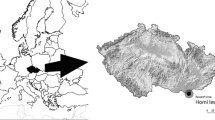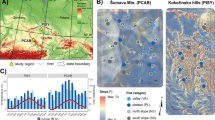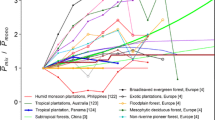Abstract
Context
Wood density variation affects structural timber performance and is correlated with several potentially confounding factors, such as cambial age, position in the stem and growth rate. To date, these relationships have not been comprehensively quantified in black spruce (Picea mariana (Mill.) B.S.P.).
Aims
The aim of this study was to describe the variation in annual ring density in black spruce as a function of cambial age, stem height and growth rate.
Methods
Radial density profiles from 107 black spruce trees were analysed using a two-stage modelling approach. First, the parameters of a nonlinear function were estimated separately for individual samples. Linear regression was then used to model the parameters obtained in the first stage as functions of internal and external tree descriptors.
Results
Annual ring density was high near the pith and declined rapidly in the first 15 annual rings before increasing to more stable values between rings 25 and 60. However, just below 25 % of the samples showed a gradual decline towards the bark, typically after ring 60.
Conclusion
Describing and quantifying radial density patterns, including the decline close to the bark, will help further our understanding of the links between tree growth and ring density over the life of the tree.






Similar content being viewed by others
References
Achim A, Gardiner BA, Leban J-M, Daquitane R (2006) Predicting the branching properties of Sitka spruce grown in Great Britain. NZ J For Sci 36:246–264
Alteyrac J, Zhang SY, Cloutier A, Ruel JC (2005) Influence of stand density on ring width and wood density at different sampling heights in black spruce (Picea mariana (Mill.) BSP). Wood Fiber Sci 37:83–94
Auty D, Achim A (2008) The relationship between standing tree acoustic assessment and timber quality in Scots pine and the practical implications for assessing timber quality from naturally regenerated stands. Forestry 81:475–487
Auty D, Gardiner BA, Achim A, Moore JR, Cameron AD (2012) Models for predicting microfibril angle variation in Scots pine. Ann For Sci 70:209–218
Bigler C, Bugmann H (2003) Growth-dependent tree mortality models based on tree rings. Can J Forest Res 33:210–221
Bigler C, Bugmann H (2004) Predicting the time of tree death using dendrochronological data. Ecol Appl 14:902–914
Bouriaud O, Bréda N, Moguédec G, Nepveu G (2004) Modelling variability of wood density in beech as affected by ring age, radial growth and climate. Trees-Struct Funct 18:264–276
Boyle TJB, Balatinecz JJ, McCaw PM (1989) Genetic control of some wood properties in black spruce. Proceedings of the Twenty-First Meeting of the Canadian Tree Improvement Association, Part 2, pp 17–21
Brazier JD (1970) Timber improvement. II: The effect of vigour on young growth Sitka spruce. Forestry 43:135–150
Brazier JD (1977) The effect of forest practices on quality of the harvested crop. Forestry 50:49–66
Core Team R (2013) R: a language and environment for statistical computing. R Foundation for Statistical Computing, Vienna
Cregg BM, Dougherty PM, Hennessey TC (1988) Growth and wood quality of young loblolly pine trees in relation to stand density and climatic factors. Can J Forest Res 18:851–858
De Vries WIM, Reinds GJ, Gundersen PER, Sterba H (2006) The impact of nitrogen deposition on carbon sequestration in European forests and forest soils. Glob Change Biol 12:1151–1173
Duchateau E, Longuetaud F, Mothe F, Ung C, Auty D, Achim A (2013) Modelling knot morphology as a function of external tree and branch attributes. Can J For Res 43:266–277
Evans R (1994) Rapid measurement of the transverse dimensions of tracheids in radial wood sections from Pinus radiata. Holzforschung 48:68–172
Franceschini T, Bontemps JD, Gelhaye P, Rittie D, Herve JC, Gegout JC, Leban JM (2010) Decreasing trend and fluctuations in the mean ring density of Norway spruce through the twentieth century. Ann For Sci 67:816–826
Franceschini T, Lundquist SO, Bontemps JD, Grahn T, Olson L, Evans R, Leban JM (2012) Empirical models for radial and tangential fibre width in tree ring of Norway spruce in north-western Europe. Holsforschung 66:219–230
Franceschini T, Longuetaud F, Bontemps JD, Bouriaud O, Caritey BD, Leban JM (2013) Effect of ring width, cambial age, and climatic variables on the within-ring wood density profile of Norway spruce Picea abies (L.) Karst. Trees 27:913–925
Gardiner B, Leban JM, Auty D, Simpson H (2011) Models for predicting wood density of British-grown Sitka spruce. Forestry 84:119–132
Guilley E, Hervé JC, Nepveu G (2004) The influence of site quality, silviculture and region on wood density mixed model in Quercus petraea Liebl. Forest Ecol Manag 189:111–121
Hall JP (1984) The relationship between wood density and growth rate and the implications for the selection of black spruce plus trees. For Res Cent Inf Rep N-X-224, Can For Serv, St-John’s Newfoundland
Hein S, Weiskittel AR (2010) Cutpoint analysis for models with binary outcomes: a case study on branch mortality. Eur J Forest Res 129:585–590
Jaakkola T, Mäkinen H, Saranpää P (2005) Wood density in Norway spruce: changes with thinning intensity and tree age. Can J Forest Res 35:1767–1778
Jozsa LA, Middleton GR (1994) A discussion of wood quality attributes and their practical implications. Forintek Canada Corp,Vancouver, BC Special Publ. No. SP-34
Jyske T, Mäkinen H, Saranpää P (2008) Wood density within Norway spruce stems. Silva Fenn 42:439–455
Ketterings QM, Coe R, van Noordwijk M, Ambagau Y, Palm CA (2001) Reducing uncertainty in the use of allometric biomass equations for predicting above-ground tree biomass in mixed secondary forests. Forest Ecol Manag 146:199–209
Koga S, Zhang SY (2004) Inter-tree and intra-tree variations in ring width and wood density components in balsam fir (Abies balsamea). Wood Sci and Technol 38:149–162
Koubaa A, Zhang SY, Isabel N, Beaulieu J, Bousquet J (2000) Phenotypic correlations between juvenile–mature wood density and growth in black spruce. Wood Fiber Sci 32:61–71
Koubaa A, Isabel N, Zhang SY, Beaulieu J, Bousquet J (2005) Transition from juvenile to mature wood in black spruce (Picea Mariana (Mill.) BSP). Wood Fiber Sci 37:445–455
Larson PR (1969) Wood formation and the concept of wood quality. Yale Univ Sch For Bull 74:1–54
Lei YC, Zhang SY, Jiang Z (2005) Models for predicting lumber bending MOR and MOE based on tree and stand characteristics in black spruce. Wood Sci Technol 39:37–47
Lohrasebi H, Mabee WE, Roy DN (1999) Chemistry and pulping feasibility of compression wood in black spruce. J Wood Chem Technol 19:13–25
Mäkinen H, Saranpää P, Linder S (2002) Wood-density variation of Norway spruce in relation to nutrient optimization and fibre dimensions. Can J Forest Res 32:185–194
Mäkinen H, Jaakkola T, Piispanen R, Saranpää P (2007) Predicting wood and tracheid properties of Norway spruce. Forest Ecol Manag 241:175–188
Marconetto MB (2010) Paleoenvironment and anthracology: determination of variations in humidity based on anatomical characters in archealogical plant charcoal (Ambato Valley, Catamarca, Argentina). J Archaeol Sci 37:1186–1191
McLane SC, LeMay VM, Aitken SN (2011) Modeling lodgepole pine radial growth relative to climate and genetics using universal growth-trend response functions. Ecol Appl 21:776–788
Panshin A, De Zeeuw C (1980) Textbook of wood technology. McGraw-Hill, New York
Parresol BR (1999) Assessing tree and stand biomass: a review with examples and critical comparisons. Forest Sci 45:573–593
Pinheiro JC, Bates DM (2000) Mixed-effects models in S and S-PLUS. Springer, New York
Plonski WL (1956) Normal yield tables for black spruce, jack pine, aspen and white birch in northern Ontario. Ont Dept Lands For Toronto, ON Rep 24:229–244
Risi J, Zeller E (1960) Specific gravity of the wood of Black Spruce (Picea Mariana (Mill.) BSP) grown on a Hylocomium–Cornus site type. Univ Laval, For Res Found. Québec, Canada
Robichaud E, Methven IR (1993) The effect of site quality on the timing of stand breakup, tree longevity, and the maximum attainable height of black spruce. Can J For Res 23:1514–1519
Savva Y, Koubaa A, Tremblay F, Bergeron Y (2010) Effects of radial growth, tree age, climate, and seed origin on wood density of diverse jack pine populations. Trees-Struct Funct 24:53–65
Schär E, Schweingruber FH (1987) Nacheiszeitliche Stammfunde aus Grächen im Wallis. Schweizerische Zeitschrift für das Forstwesen 138:497–515
Simpson HL, Denne MP (1997) Variation of ring width and specific gravity within trees from unthinned Sitka spruce spacing trial in Clocaenog, North Wales. Forestry 70:31–45
Smith DM, Larson BC, Kelty MJ, Ashton PM (1997) The practice of silviculture: applied forest ecology. Wiley, New York
Swenson NG, Enquist BJ (2007) Ecological and evolutionary determinants of a key plant functional trait: wood density and its community-wide variation across latitude and elevation. Am J Botany 94:451–459
Telewski FW (1989) Structure and function of flexure wood in Abies fraseri. Tree Physiol 5:113–121
van Buijtenen JP (1982) Fiber for the future. Tappi 65:10–12
Wang L, Payette S, Begin Y (2002) Relationships between anatomical and densitometric characteristics of black spruce and summer temperature at tree line in northern Quebec. Can J Forest Res 32:477–486
Wimmer R, Downes GM (2003) Temporal variation of the ring width-wood density relationship in Norway spruce grown under two levels of anthropogenic disturbance. IAWA J 24:53–61
Zhang SY (1998) Effect of age on the variation, correlations and inheritance of selected wood characteristics in black spruce (Picea mariana). Wood Sci Technol 32:197–204
Zhang SY, Morgenstern EK (1995) Genetic-variation and inheritance of wood density in black spruce (Picea mariana) and its relationship with growth—implications for tree breeding. Wood Sci Technol 30:63–75
Zhang SY, Owoundi RE, Nepveu G, Mothe F, Dhote JF (1993) Modeling wood density in European oak (Quercus petraea and Quercus robur) and simulating the silvicultural influence. Can J Forest Res 23:2587–2593
Zhang SY, Simpson D, Morgenstern EK (1996) Variation in the relationship of wood density with growth in 40 black spruce (Picea mariana) families grown in New Brunswick. Wood Fiber Sci 28:91–99
Zhang SY, Chauret G, Ren HQ, Desjardins R (2002) Impact of initial spacing on plantation black spruce lumber grade yield, bending properties, and MSR yield. Wood Fiber Sci 34:460–475
Acknowledgments
This study is part of a project supported by the NSERC ForValueNet Strategic Network. The authors would like thank Daniel Corbett and Northwest Regional Growth and Yield field staff at Northwest Science and Information (OMNR) for the field work and field data. Many thanks also to our colleagues who helped with the laboratory work, including Stephane Comeault, Dr. Xiaodong Wang, Stephen Elliott, Brent Forbes, Dr. Marek Holpit and Dr. Thakur Upadhyay. We also sincerely thank Dr. Jean-Michel Leban and two anonymous reviewers for their useful comments on the manuscript.
Funding
Financial support for this project came from NSERC-ForValueNet and Living Legacy Trust.
Author information
Authors and Affiliations
Corresponding author
Additional information
Handling Editor: Jean-Michel Leban
Contribution of the co-authors
Wei Xiang was the principal investigator for this study. He undertook sample processing and laboratory measurements, carried out the main data analyses and wrote the manuscript.
Mathew Leitch was the main supervisor for the project. He supervised the work and helped in developing the methodology for the study, interpreting results and revising earlier drafts until final approval.
David Auty contributed to the development of the model and to the interpretation and presentation of the statistical results and revised the text.
Emmanuel Duchateau assisted the first author in developing the modelling approach and in finding a strategy to increase the convergence of the nonlinear models. He also contributed to the interpretation and presentation of the statistical results.
Alexis Achim was the co-supervisor for the project. He assisted with developing the methodology for the study, supervised the development of the model and revised the text.
Rights and permissions
About this article
Cite this article
Xiang, W., Leitch, M., Auty, D. et al. Radial trends in black spruce wood density can show an age- and growth-related decline. Annals of Forest Science 71, 603–615 (2014). https://doi.org/10.1007/s13595-014-0363-7
Received:
Accepted:
Published:
Issue Date:
DOI: https://doi.org/10.1007/s13595-014-0363-7




